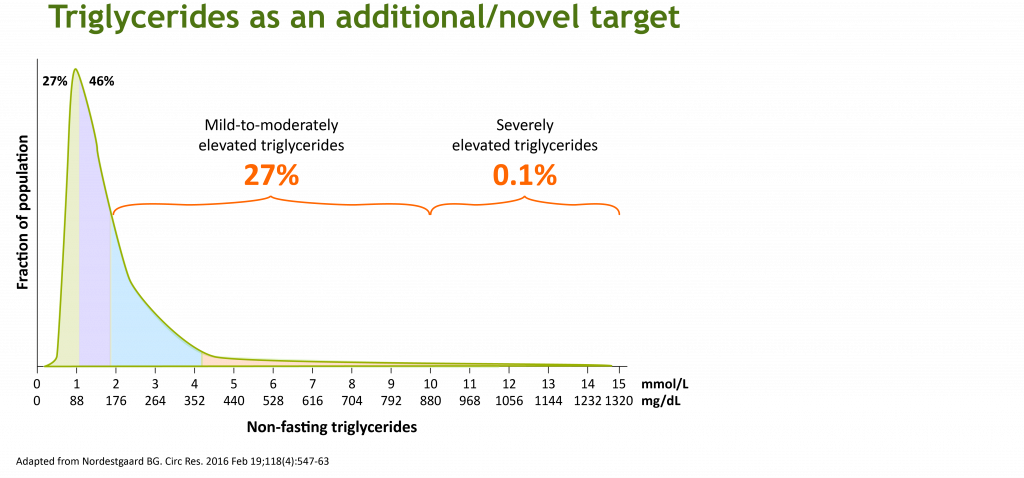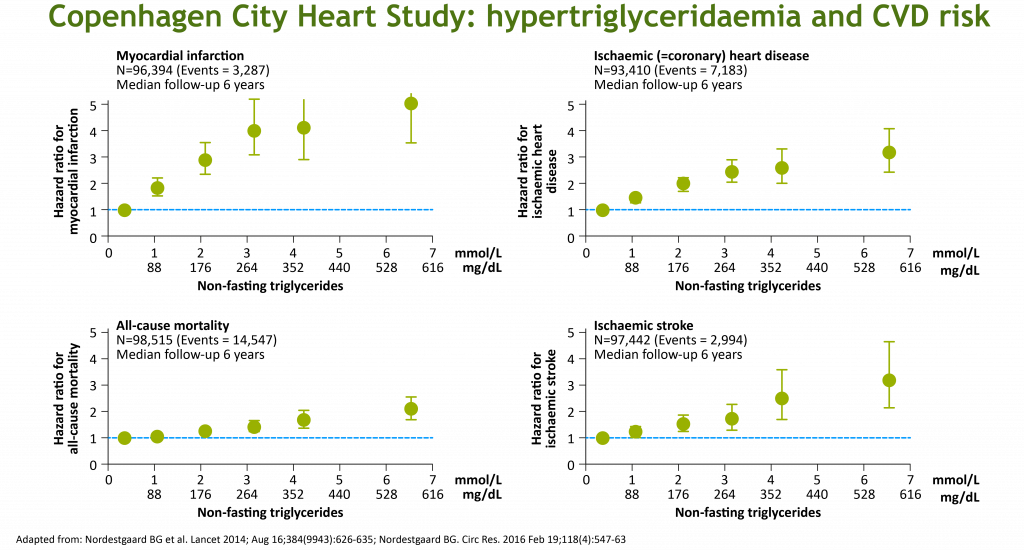Classification
The classification of hypertriglyceridaemia is evolving but a triglyceride (TG) level ≥1.7 mmol/L (150 mg/dL) is typically considered to be elevated.1,2
Recent European Atherosclerosis Society (EAS) consensus definitions of a normal TG level and hypertriglyceridaemia are:1
| Category | Triglyceride level mmol/L (mg/dL) |
| Optimal | <1.2 (<100) |
| Borderline | 1.2-1.7 (100-150) |
| Moderately elevated | 1.7-5.7 (150-500) |
| Severe | 5.7-10.0 (500-880) |
| Extreme | >10 (>880) |
The American College of Cardiology (ACC) defines hypertriglyceridaemia as:2
| Category | Triglyceride level (mg/dL) |
| Mild to moderate hypertriglyceridaemia | ≥150 (fasting)/≥175 (non-fasting) |
| Severe | ≥500 (fasting) |
Epidemiology
Hypertriglyceridaemia is a common problem in clinical practice and its prevalence is increasing alongside that of obesity and type 2 diabetes.3 In the Copenhagen General Population Study, 27% of patients had non-fasting TG levels of 2-10 mmol/L (176-880 mg/dL) and 0.1% had non-fasting TG levels >10 mmol/L (>880 mg/dL).4

Hypertriglyceridaemia is associated with increased risk of atherosclerotic cardiovascular disease (ASCVD)1,2 and, in more severe cases (TG >10 mmol/L [>885 mg/dL]), with pancreatitis.3
In the Copenhagen City Heart Study, there was an approximately three to four-fold increased risk of myocardial infarction at moderately elevated TG levels.4,5

Aetiology
The primary causes of hypertriglyceridaemia are genetic, with both mono- and polygenic involvement.3
Secondary causes of hypertriglyceridaemia can be summarised as:3
|
|
References
- Ginsberg HN, Packard CJ, Chapman MJ et al. Triglyceride-rich lipoproteins and their remnants: metabolic insights, role in atherosclerotic cardiovascular disease, and emerging therapeutic strategies—a consensus statement from the European Atherosclerosis Society. European Heart Journal 2021 Dec 14; 42(47):4791-4806.
- Virani SS, Morris PB, Agarwala A et al. 2021 ACC Expert consensus decision pathway on the management of ASCVD risk reduction in patients with persistent hypertriglyceridemia. J am Coll Cardiol 2021; Aug, 78 (9) 960–993
- Laufs U, Parhofer KG, Ginsberg HN et al. Clinical review on triglycerides. European Heart Journal 2020; 41:99-109
- Nordestgaard BG. Triglyceride-Rich Lipoproteins and Atherosclerotic Cardiovascular Disease: New Insights From Epidemiology, Genetics, and Biology. Circ Res. 2016 Feb 19;118(4):547-63
- Nordestgaard BG, Varbo A. Triglycerides and cardiovascular disease. Lancet. 2014; 384:626–635




